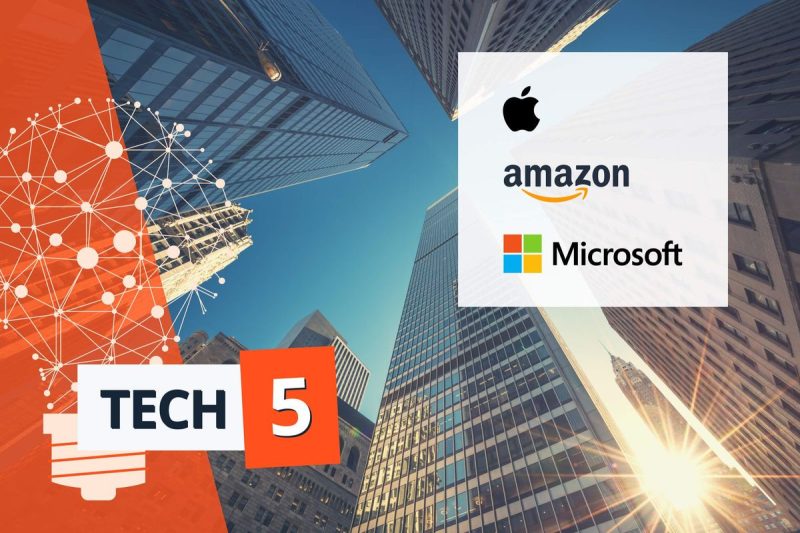A week of earnings reports and troubling economic data sent tech stocks on a wild ride this week.
Meanwhile, US President Donald Trump made an appearance at a Bitcoin event in Nashville, Tennessee, promising a friendly environment for crypto if he is elected in November — including a strategic Bitcoin reserve.
Additionally, the competitive chip stock landscape is about to get a new competitor.
1. Major indexes go for a bumpy ride
Major indexes experienced a modest upswing at the start of the week in anticipation of quarterly earnings reports from Apple (NASDAQ:AAPL), Amazon (NASDAQ:AMZN), Microsoft (NASDAQ:MSFT) and a handful of semiconductor companies.
Concerns about the overvaluation of artificial intelligence (AI) stocks and anticipation of the two day US Federal Reserve meeting led to fluctuations in the market on Monday (July 29) and Tuesday (July 30), resulting in a decline in the S&P 500 (INDEXSP:.INX) and Nasdaq Composite (INDEXNASDAQ:.IXIC) during after-hours trading on Tuesday.
Conversely, an optimistic outlook from Advanced Micro Devices (NASDAQ:AMD) (AMD) triggered a pivot into chip stocks that continued into Wednesday (July 31) morning.
On Wednesday afternoon, the Fed released its statement, announcing it would hold interest rates but that depending on further data interest rates could be lowered in September. Coupled with a heavy day of earnings reports from chipmakers and tech stocks, major indices surged. Both mega-cap and small-cap indices witnessed gains, with the S&P 500 having its best day in five months. Additionally, the Toronto Stock Exchange hit a new record of 23,000 points.
However, these gains were reversed on Thursday (August 1) when fresh data from the Institute of Supply Management revealed a 1.7 percent decline in the Manufacturing PMI to 46.8 percent in July, indicating contraction. Consequently, the Cboe Volatility Index spiked to a three-month high of 19.48.
Indices ended lower across the board on Thursday and markets opened in the red across the board on Friday (August 2) morning. Later, the US July employment report revealed that the unemployment rate grew to 4.3 percent in July, signaling signs of an economic slowdown and stoking fears of a potential recession. A large sell-off of volatile stocks by funds focused on stability ensued as investors continued to shift their focus to bonds.
As of Friday’s close, the Nasdaq Composite had declined over 10 percent from the all-time high it set on July 10, confirming that the market is in a correction.
2. Earnings season culminates with clear winners and losers
It was a busy week of earnings reports, with several of the most influential tech and chip stocks releasing quarterly results. First up were Microsoft and AMD, which were released just after the closing bell on Tuesday.
Investors had an unfavorable reaction to Microsoft’s plan to increase spending on AI even further this year. The sentiment was also dampened by slow growth in Microsoft’s cloud business.
The company’s share price had fallen by 1.96 percent by mid-day Wednesday.
AMD disclosed a positive revenue forecast thanks to growth spurred by its new AI processor, sending shares up by 9.2 percent in pre-market trading on Wednesday, along with a handful of other chip stocks that rose between 2 and 5 percent before the bell.
Qualcomm’s (NASDAQ:QCOM) Q3 earnings report, released after trading closed on Wednesday, provided an optimistic earnings forecast that initially caused an increase in share prices. However, during the subsequent earnings call, CEO Cristiano Amon’s remarks indicated that phone shipments might have a slow recovery. As a result, share prices declined by 4.84 percent by Thursday morning.
Likewise, shares for Arm Holdings (NASDAQ:ARM) tumbled 10.73 percent after the company did not raise its annual revenue forecast for its fiscal Q1 2025 earnings report.
Shares of Meta Platforms (NASDAQ:META) rose by 9.77 percent after the release of its Q2 earnings report on Wednesday. While it too planned to spend more on AI infrastructure in the coming months, high sales of its Meta glasses and increased ad revenue contributed to sales of US$39.1 billion compared to estimates of US$38.3 billion.
On Thursday morning, shares of Amazon and Apple gained 1.4 percent and 0.9 percent, respectively, ahead of their results, which were released after markets closed on Thursday.
Amazon’s results showed slow online sales growth in Q2, which the company’s CFO Brian Olsavsky attributed to consumers being more cautious with their spending. Disappointed investors sent the share price down from US$184.07 to US$166.53 on Friday morning. Apple fared better; its Q3 results reported revenue from iPad and iPhone sales and its service division that came in above analysts’ projections. The company’s share price opened US$0.54 percent higher on Friday morning and reached a high of US$224.61.
Shares of Intel (NASDAQ:INTC) took the biggest hit this week, after its Q2 report released Thursday forecasted quarterly revenue below estimates. Additionally, the company said it would be cutting 15 percent of its workforce and suspending dividend payments as it attempts to restructure its chipmaking business. Its stock fell 24.37 percent from its close of US$29.05 in after-hours trading and kept sinking after the opening bell on Friday, reaching a low of US$20.60 during trading.
3. Trump reaffirms support for crypto
Bitcoin saw its price surge on Sunday (July 28) following comments from Trump at the Bitcoin Conference. On Saturday (July 27), Trump maintained his support of crypto, telling audience members he would fire the US Securities and Exchange Commissioner Gary Gensler and establish a strategic national Bitcoin stockpile if elected.
Bitcoin came within reach of its previous US$70,000 high on Monday morning. However, gains were rapidly reversed as news broke of the US government transferring US$2 billion worth of seized Bitcoin to two new wallets, sparking fears of a sell-off and triggering a 4.27 percent drop in valuation to US$66,843 on Tuesday.
Meanwhile, Tuesday also marked the first full week of trading spot Ether ETFs. After an explosive first day, data showed eight spot Ether ETFs recorded inflows, although they were outweighed by outflows from the Grayscale Ethereum Trust (ARCA:ETHE). However, net positive inflows were recorded for the first time on Tuesday and again on Wednesday, possibly contributing to a slight increase observed in Ether’s valuation.
Overall, Bitcoin and Ether both trended mostly downward this week. Some upward momentum was observed following the Fed’s statement on Wednesday, but gains were quickly erased as emerging employment data sent fears of a possible recession rippling through the markets.
4. Pro-crypto senator introduces BITCOIN bill
Pro-crypto Senator Cynthia Lummis (R-Wy) introduced a bill on Wednesday that would see the US government create a reserve fund for Bitcoin, as Trump promised to do during his Bitcoin Conference address.
The Boosting Innovation, Technology, and Competitiveness through Optimized Investment Nationwide (BITCOIN) Act of 2024 calls for the US Secretary to purchase up to 200,000 Bitcoin per year over five years, resulting in the purchase of 1,000,000 Bitcoins — roughly 5 percent of the total supply — held for at least 20 years.
The bill also details where the funds for the endeavor will come from.
The bill has provisions to reaffirm the right to self-custody, or the ability of individuals to control their own assets without third-party intermediaries like centralized exchanges or custodial services.
5. Cerebras Systems files for IPO
Cerebras Systems, an AI company specializing in the development of computer systems for deep learning applications, confidentially filed an initial public offering (IPO) on Thursday.
The company has developed some innovative solutions in the AI space, including its Wafer-Scale Engine that’s designed to replace clusters of GPUs and CS-2 systems, making it a worthy contender in the competitive landscape of AI hardware.
Cerebras has some significant backers, including Alpha Wave Ventures, G42 and Benchmark Capital. The company achieved unicorn status back in 2018 when it closed its series D funding round with US$88 million, bringing its valuation above US$1 billion.
Securities Disclosure: I, Meagen Seatter, hold no direct investment interest in any company mentioned in this article.





